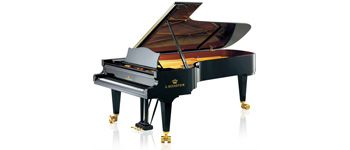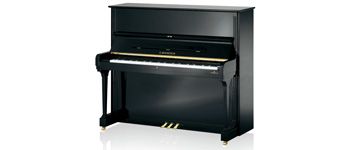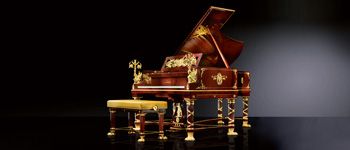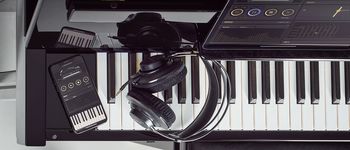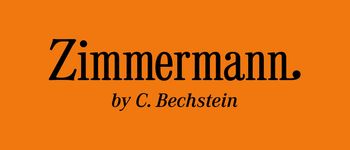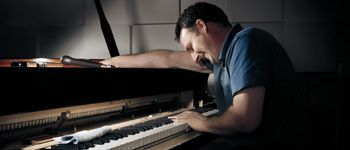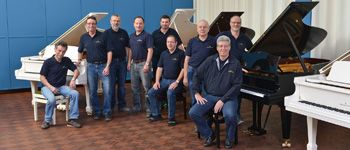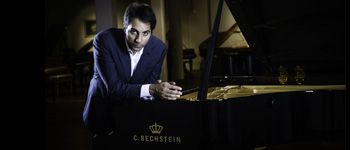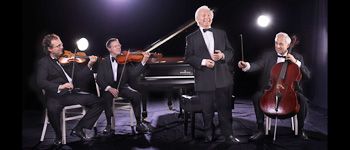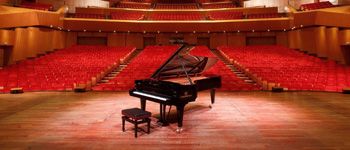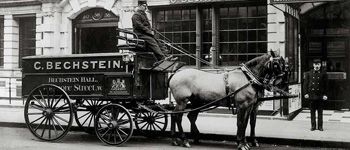Bechstein-Tradition
Highest quality since 1853. Browse through the history of our company.
Karl Schulze, a visionary and courageous entrepreneur, took over Bechstein in 1986
Karl Schulze takes over Bechstein
Then a new personality steps in: Karl Schulze, a thirty-eight-year old master piano-maker, owner of the Piano Sprenger shop in Oldenburg, Lower Saxony. Baldwin has already asked him twice to become Bechstein’s managing director, but he refused: his target is to take over the traditional Berlin brand and run it independently. To that end, he develops a financing plan with a Berlin bank, and becomes Bechstein’s new owner in May 1986.
Schulze’s concept, which provides for restructuring and repositioning Bechstein in the top-segment market, is rapidly successful. Shortly after the takeover, the new boss clearly presents his goal in a letter sent to all Bechstein dealers: “The Bechstein brand is to become once again what it had been from the very beginning: the epitome of excellence”. The company introduces a new grand piano on the occasion of the 1987 Frankfurt Music Fair: the model K with a length of 158 centimetres. In 1987, the turnover increases by four million marks over the previous year to reach fourteen million.
In 1988, Bechstein moves from the old production site in Reichenberger Strasse to a modern building in Prinzenstrasse near Checkpoint Charlie, still in Berlin-Kreuzberg. The international economic situation is favourable, as “perestroika” and “glasnost” are now the keywords in the Soviet Union, giving rise to the hope of opening new markets in Eastern Europe. Nonetheless, the changes soon prove to be much more radical that anyone forecasted, and the fall of the Berlin Wall in November 1989 introduces a new, turbulent era.
But optimism is still on the agenda in 1990. Bechstein takes over Euterpe, a small business founded in Berlin that moved to Langlau, Franconia, after the Second World War, and took over W.Hoffmann in 1977.
The former “Sächsische Pianofortefabrik” in Seifhennersdorf, today’s C. Bechstein production site
Facing the future
Although worldwide piano production drops by forty percent that year, Karl Schulze shows his audacity again in 1992: just two years after German reunification, he also takes over the Zimmermann brand and its production site in Seifhennersdorf, Saxony. The region is backed by a long tradition in musical instrument manufacturing, and personnel costs are considerably lower there than in Berlin. Moreover, Zimmermann is among Germany’s leading piano-makers. Schulze thus took the right decision, even though the economy loses momentum. Eastern European markets are collapsing and, within the framework of German reunification, the federal government prioritises the modernisation of infrastructures in the area that once formed the GDR.
The Langlau production site ceases operation in June 1993 and the redundancy package is such a burden that the company must apply for bankruptcy. The news goes around the world and everybody worries: will this be the end of the Bechstein tradition? The Berlin Senate, conversely, remains unperturbed, probably because local politicians are not really interested in culture, preferring to focus on the gigantic Potsdamer Platz urban development project, with its high-rises and possible speculation benefits. Selling the production plant at Prinzenstrasse could save the company and prospective buyers are at hand, but the State of Berlin, which has a pre-emption right, first decides… to do nothing. At the last moment, when it is nearly too late, the local authorities finally buy the real estate — at a price that pre-dated the fall of the Wall, of course.
At the same time, various initiatives are launched to support Bechstein, as the brand has a strong emotional charge: Bechstein still embodies the ideal of “Athens on the Spree,” even though local politicians consider Berlin more a boomtown than a cultural epicentre. Particularly noteworthy is an action launched by twelve international artists, who transform a concert grand piano into a gesamtkunstwerk.
“To my ear, the Bechstein sound is a clear, transparent, singing voice.”
Naoki Yamauchi-Pohl
Bechstein goes public again
A tenacious businessman, Karl Schulze finds a solution to secure the company’s financial situation: Bechstein goes public again in 1996, whereby forty percent of the capital is made available to private investors. Thus the company can invest fifteen million euros to modernise the Seifhennersdorf factory in the four last years of the 20th century, while the management offices and the showroom move to an ultramodern building located in Berlin-Charlottenburg’s Kantstrasse in 1999. That state-of-the-art structure made of steel, glass and concrete, called “Stilwerk”, houses exclusively the finest brands, making it a “temple to good taste.” The Bechstein pianos are exhibited there in an environment that corresponds to the daily settings of the brand’s customers and mirrors their lifestyle: designer furniture, modern home fabrics, espresso machines, and so forth. A kind of museum of modern art where you can touch and buy the exhibited pieces, the Stilwerk is also a place for communication and gatherings, a cultural centre where concerts are regularly held. What a change from the time when Carl Bechstein invited Berlin’s high society to recitals in his exclusive villa on the outskirts of the city! Today, music lovers and Bechstein aficionados come to a venue in the very city centre, to a temple of Italian design and German piano-making. As the concept proves to be successful, the Bechstein showroom in Rhineland soon moves to a similar structure: Dusseldorf’s Stilwerk.
All Bechstein pianos are now made at the Seifhennersdorf factory and the product range can satisfy any pianist as it includes the C. Bechstein model D concert grand (top segment), the Zimmermann instruments (middle segment) and the affordable W.Hoffmann pianos. Moreover, Bechstein develops the Vario digital mute for those who want to play as they like without disturbing their neighbours and family members. This device, which provides a traditional instrument with the advantages of an electronic piano, is in a way the comeback of the Neo-Bechstein. As a result, the company revenues amount to nearly forty million euros by the turn of the millennium.
Modern design: the Bechstein Ars Nova upright
Award winning design
In the early 2000s, Bechstein sets another milestone in cultural history when it launches the ProBechstein range. These instruments re-invent the upright piano, the product at the origin of the Bechstein tradition 150 years earlier: case of contemporary elegance, proportions inspired by the ancient golden rule, clear and differentiated design that crystallises in the shape of a piano, aesthetics that recall the works of Jean Nouvel or Sir Norman Foster. Once bulky and unsightly, the upright has now taken on sculptural qualities. One of the three models within the ProBechstein range bears the name “Ars Nova”, an expression with a double connotation. First, one thinks of “art nouveau,” of course, that style born in the late 19th century as great designers and architects joined their efforts to provide industrial products with a new aesthetic. But the Latin name “ars nova” also relates to a revolution that introduced isorhythmic motet in French music in the early 14th century. For the outstanding quality of its design, the new ProBechstein range is awarded a highly coveted international prize, the Good Design Award.
In 2003, on the occasion of the company’s 150th anniversary, Bechstein celebrates a glorious past while the recent successes promise a bright future. Various concerts and events are organised on this occasion in Berlin, the new capital of the Federal Republic of Germany, a city that attracts the attention of the world with great architectural projects such as the new Chancellery and the Reichstag cupola designed by Sir Norman Foster. In such a context, it is not surprising that the media widely report on the first Bechstein jubilee of the 21st century.
